The Chinese Shar-Pei is an ancient breed of dogs originated in China over 2000 years ago.
The Chinese Shar Pei breed of dogs is one of the kind companion and guardian dog.
Originally bred to be herding guard dogs, Shar-Pei dogs are now family dogs who love to laze around on couches.
They may be lazy, yes, but they are also as alert and agile to any threat. They are extremely loyal pets but also are suspicious of strangers.
The name Shar Pei translates to sandpaper-like because their skin is very hard to touch.
They are medium-sized dogs, who are on the heavier side.
They are known for their sharp, small coat, loose wrinkled bodies. They closely resemble Chow Chow too.
Table of Contents
Chinese Shar Pei Pictures:
Chinese Shar Pei Facts:

Avg. Weight: 25-30 kg (Male), 18-25 kg (Female).
Avg. Height: 46-56 cm.
Life Expectancy: 9-11 years.
Dog Group: Non-Sporting Group.
Colors: Solid Red, Fawn, Cream, Black, White.
At A Glance:
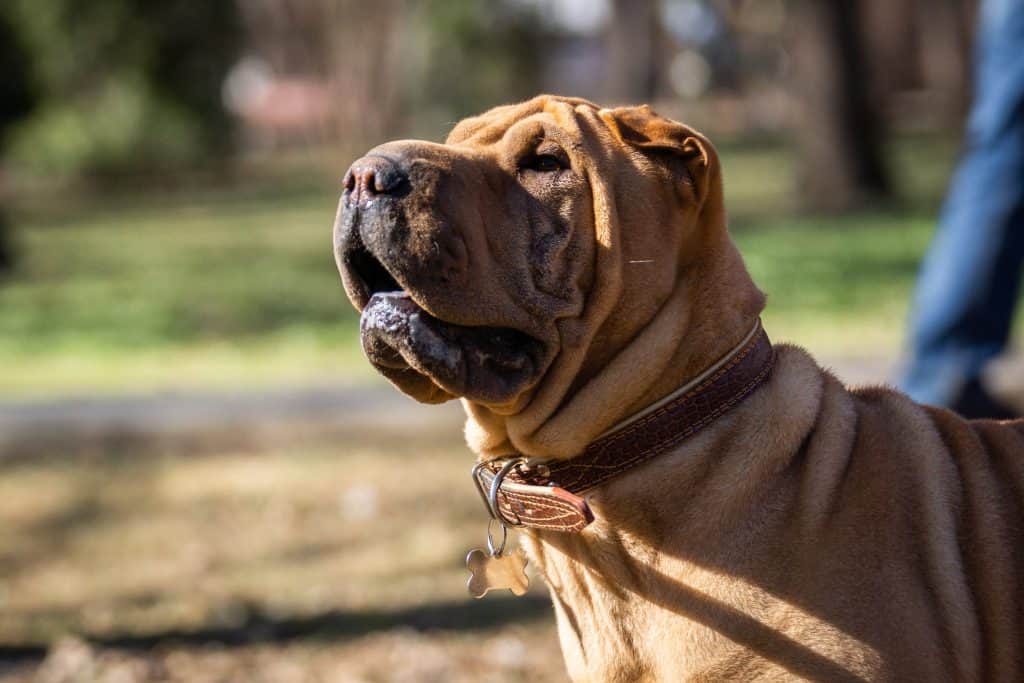
- Size (3/5)
The Chinese Shar Pei dog is about 46-56 cms tall.
A male would weigh about 25-30 kgs and a female would weigh anywhere between 18-25 kgs.
An average Chinese Sher Pei size is moderate, they are categorized as Non-sporting dogs.
- Affection Level (2/5)
The Chinese Shar Pei dog is extremely affectionate towards humans. They will smother you with kisses and throw themselves at you.
They are independent, reserved and suspicious of strangers. If socialized in her early years, they can become amenable to people who it doesn’t know.
- Apartment Friendly (4/5)
The size of your dog, sometimes, does not determine whether it is apartment-friendly or not.
Same is the case with Chinese Shar Pei.
Despite their big size, they are perfectly suited for apartment living and can live in small spaces too.
- Cold Weather Tolerability (2/5)
Shar Pei dogs enjoy the cold weather a lot.
However, because of their short and small coat, the need sweaters or warm clothes to stay for longer periods in cold weather.
- Hot Weather Tolerability (1/5)
Because of their “hippopotamus like” muzzle, they find it harder to breathe in hot weather. Hence, it is advised to not keep them in hot weather longer than required.
- Barking Tendencies (1/5)
Shar Pei dogs are known to be silent dogs, they are known to bark in times of playfulness or worry.
- Cat-Friendly (1/5)
Shar Pei was initially meant to be herding dogs, hence they tend to chase and seize cats or other furry animals.
- Dog-Friendly (1/5)
Shar Pei dogs do not get along with other dogs, especially of the same sex.
They need to know who is the leader of the pack or they become very competitive and start fighting on their own.
- Exercise Needs (3/5)
This breed of dog does not need too much exercise.
A 30 min walk and a few games during the day should suffice.
- Grooming Needs (5/5)
Shar Pei dogs need very minimal grooming.
They need to be bathed only once every three months or when they are dirty, whichever comes earlier.
- Playfulness (3/5)
The Chinese Shar Pei dog is extremely playful in addition to being loyal.
They enjoy games and treats too.
However, giving them too many treats could make them obese.
- Trainability (3/5)
They are known to be highly intelligent dogs and respond well to training.
They are very easy to housebreak.
They are smart and quick to understand commands.
- Intelligence (2/5)
They are very smart and bright. They have a mind of their own.
They can be stubborn too, so they need an owner who is assertive and can control him.
The Chinese Shar Pei temperament is calm and collected.
They are also extremely devoted to their family.
- Mouthiness (2/5)
Chinese Shar Pei dogs are not known for drooling too much.
However, an angered Shar Pei dog will bite a dog/person. The owner should know how to control it.
- Price Group
Your budget should be anywhere between $2000 to $6000.
Depending on bloodline and breeder the price will vary.
The average Chinese Shar Pei price is $900.
About Chinese Shar Pei:

Chinese Shar Pei dogs are one of the rarest dogs on this planet.
They have a lot of wrinkles on their body or loose skin, which makes them even more adorable to cuddle with.
They have a very calm temperament; they don’t fight or bark too much.
They socialize with strangers. They are very loyal to their family and extremely protective of them.
Where Chinese Shar Pei Dogs Came From?

Chinese Shar Pei history is actually quite fascinating.
These have originated from the southern provinces of China.
They date back to 2000 years although there is no definite proof to support that claim.
Although many statues look a lot like the Shar-Pei from the Han Dynasty (200 B.C.)
The Shar-Pei also resembles the Pug and Chow Chow breed of dogs.
Shar Pei dogs served as guardians, herder, hunters and fighters.
In China, however, after the establishment of the People’s Republic of China, there was a decline in this breed.
Since Communism frowned upon having dogs as pets and charged a tax on them, the population of this breed was wiped out.
A handful of Shar-Peis took refuge in Hong Kong and Taiwan.
The breed, however, carried one because of one man alone- Matgo Law, of the Down-Home Kennels in Hong Kong. If it wasn’t for his efforts, the Shar-Pei wouldn’t have lived to this day.
He brought Shar-Peis to the United States in ’73. After a sufficient number of Shar-Pei dogs were bred, the became extremely popular.
This led to the formation of the Chinese Shar-Pei Club of America Inc, in the year 1974.
In the year 1991, the American Kennel Club recognized this breed as a member of the Non-Sporting Group.
Size

Known for its stocky and compact size, Chinese Shar-Pei dogs are somewhat a weird combination of looks and features.
The head of the Shar-Pei is flat and broad, with a stop in the head, and a wide “hippopotamus” like muzzle.
There is a perpetual expression of frowning on the Shar-Pei’s face due to the folds in the skin around the forehead.
Compared to the Chinese Shar Pei size, the ears are relatively smaller.
They fold forward and are triangular in shape.
They have medium-sized, almond-shaped eyes. The color of the eyes depends on the color of the dog’s coat.
Just like the Chow Chow, Shar-Pei’s have blue-black pigmentation, almost lavender coloration around the gums, lips and the tongue.
The neck has a generous amount of skin around the neck. The skin coat consists of only primary hair, the soft undercoat is absent.
In comparison, males are taller and heftier than females.
They are around 50 cms tall weighing 25-30 kgs whereas females are shorter, some 46 cms, and weigh 18-25 kgs.
Trainability
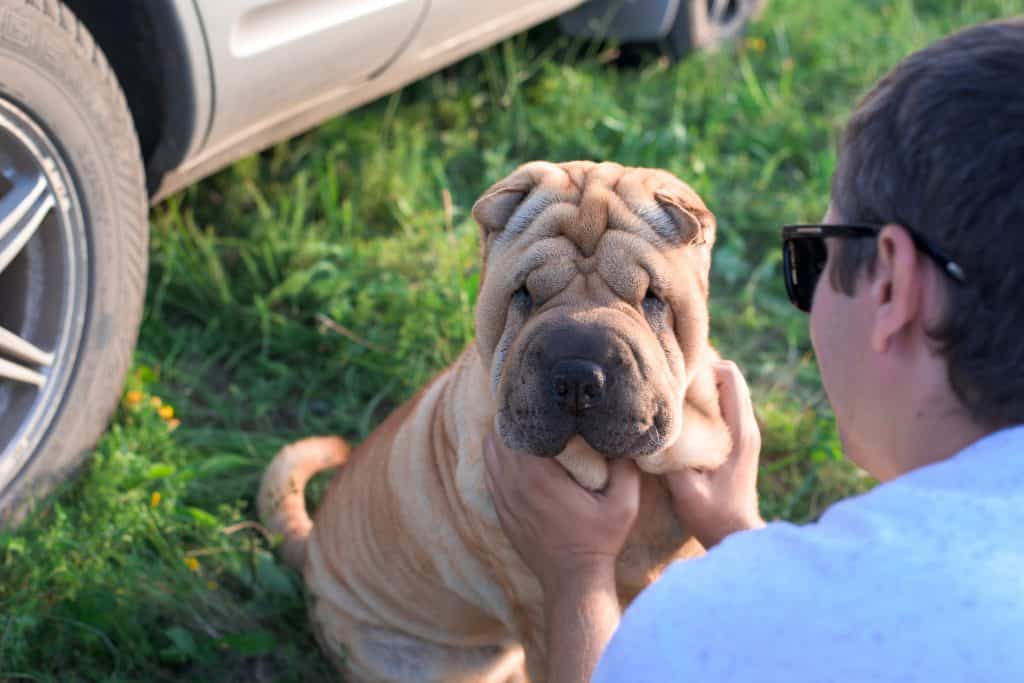
Shar-Pei dogs are easy to housebreak.
Although, the need a very firm and assertive master who can control him. They are known to have a mind of their own, you might have to deal with a few obstinate streaks of your pet.
Their stubborn and dominant nature will often make you prove that you’re in control. If they think there’s no leader of the family, they will try to be it.
But through consistent behavior and training, they will respond well to commands.
Grooming

If you’re looking for low maintenance, zero fuss dog, A Chinese Shar Pei is the right choice for you.
The sandpaper type of hair coat is the most unique characteristic of Shar-Pei. Their brush coat is not longer than a centimeter.
Their fur type does require occasional bathing for a healthy hair coat. Their coat must look healthy, not shiny.
You must be correct while choosing the products for their coat, to achieve optimal results.
You should, however, take your Shar-Pei to the groomer on a regular basis. Every two months.
Common Diseases
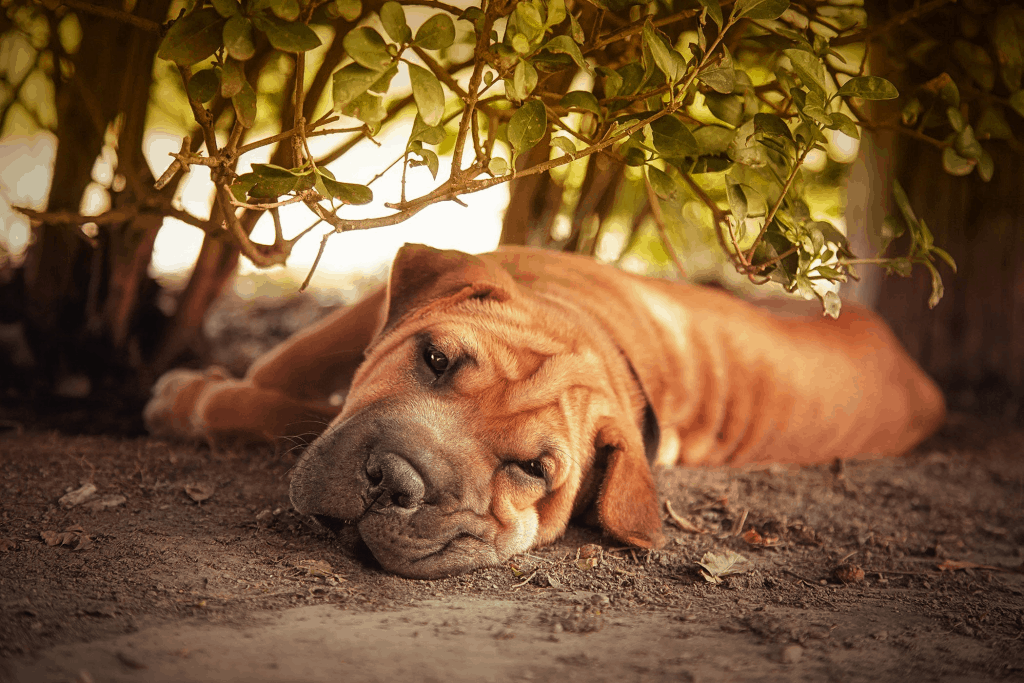
TARGETING THE BONES
- Elbow Dysplasia –
This is somewhat similar to hip dysplasia; both are degenerative diseases.
Elbow Dysplasia is said to be caused by abnormal growth resulting in a malformed and weakened joint.
There are variations in severity, it could simply be arthritis or the dog could become lame.
The treatment for elbow dysplasia could be surgery, weight management or anti-inflammatory medication.
- Hip Dysplasia –
This is an inherited condition in which the thighbone does not fit into the hip joint. Some dogs exhibit pain and lameness, either in one or both legs.
Some may not display signs of discomfort so the most certain way to check for Hip Dysplasia is X-ray.
Any Shar-Pei who is diagnosed with Hip Dysplasia should not be bred.
- Patellar Luxation:
Also known as slipped stifles, Patellar Luxation is very common in dogs.
Patella means kneecap. Luxation means, in common words, the dislocation of a joint. Patellar Luxation is when the knee joints, often of the hind legs, slides out of position.
The pain caused by this is crippling. Many dogs, however, endure it and live normal lives.
- Osteochondrosis Dissecans (OCD) –
This orthopedic condition is caused by improper growth of cartilage in the joints.
It commonly occurs in the shoulders but is seen in shoulders too.
Overfeeding of “growth formula” foods, or high protein diets may escalate the development.
Usually, it is detected as early as four to nine months.
TARGETING THE SKIN
Chinese Shar-Pei dogs are susceptible to a lot of skin diseases such as
- Demodectic Mange –
This disease is caused by Demodex mite, usually, the mother dog passes it on to her children in within the first few days of birth.
Demodex mites live in hair follicles and aren’t causing worrisome.
Until your Shar-Pei’s immune system has compromised, these mites then develop causing demodectic mange.
It is usually in patches of red, flaky, bald skin appearing on the head, neck, and forelegs.
More often so it clears up on its own but a visit to the vet is advised if you want to prevent it from happening further.
It can easily spread all over the body and cause infection.
- Pyoderma –
This is a bacterial infection and is very common in this breed. There are two types of pyoderma – primary and secondary.
Secondary pyoderma occurs from an underlying condition such as an allergy or hypothyroidism.
This can be treated with antibiotics.
- Seborrhea –
Characterized by flaky skin and a rancid odor, this is a secondary disease.
Usually occurs after the dog has an allergy or infection.
Treatment for seborrhea includes treating the underlying disease and using a medicated shampoo.
- Cutaneous Mucinosis –
This substance in the skin, Mucin, causes wrinkling in the skin.
It acts like a glue when the dog is wounded; clear.
Some Shar-Pei dogs may have a lot of mucins. This may form clear bubbles on the skin that may ooze.
This is usually associated with allergies and treated with steroid therapy.
TARGETING THE EYES
- Glaucoma –
Glaucoma is the increased pressure in the eye.
It is found in two forms – primary and secondary.
Primary glaucoma is hereditary, secondary glaucoma is caused by decreased liquid in the eyes due to other probable diseases.
Symptoms of glaucoma are loss of sight and pain, treatment and prognosis but they vary depending upon the type.
Glaucoma is treated surgically or with eye drops.
- Entropion –
This condition persists when the eyelid is rolled inwards in both eyes.
Usually occurs within a year of birth.
This disease causes loss of vision and irritation.
Surgery can be performed when the dog reached adulthood.
TARGETING THE BODY
- Shar-Pei Fever –
This is also called swollen hock syndrome.
Shar-Pei fever occurs with the swelling of the hock joint, sometimes both joints.
It makes movement very painful, causing crippling abdominal pain, diarrhea, puking, and breathlessness.
This condition usually manifests at 18 months but can also appear when the dog is an adult.
Unexplained fevers at the temperatures of 103 to 107 degrees lasting about 24 to 36 hours.
- Hypothyroidism –
This disease is a disorder of the thyroid gland, it is responsible for the occurrence of epilepsy, hair loss, hyperpigmentation, obesity, lethargy, and other skin condition.
It is treated with proper medication and diet.
- Gastric Tension –
This is a life-threatening situation that can affect large and deep-chested dogs.
This could arise if they are fed large meals or they eat rapidly or they drink too much water after eating.
This condition also called “bloat”, is common among other dogs.
It occurs when the stomach is distended with gas or air and then twists.
The dog is unable to vomit, to get rid of the excess air in the stomach. Blood pressure drops and the dog goes into shock.
If the dog isn’t taken to the vet, it can die.
Check for a bloated stomach or excessive drooling. Your dog could be breathless, depressed and lethargic. If you see these signs, call the vet immediately.
Feeding

Chinese Shar Peis need a perfect blend of proteins, carbohydrates, and unsaturated fats.
Since the Shar Pei is a large dog with a larger appetite, it is bound to eat more than smaller breeds.
Along with lean meats, it is also vital to include fruits and vegetables in the diet.
You should feed your Shar Pei, two meals a day. Make sure they are not large meals, as this breed is prone to the condition called “bloat”.
Suggested: Senior Dog Food
Do not feed your dog canned food as it has a lot of carbohydrates and could lead to obesity.
Maintaining good eating habits can hinder the occurrence of hip and elbow dysplasia.
Shar Peis should have access to cool, clean water at all times but should not drink in excess as it could lead to bloating.
Vaccination and Care
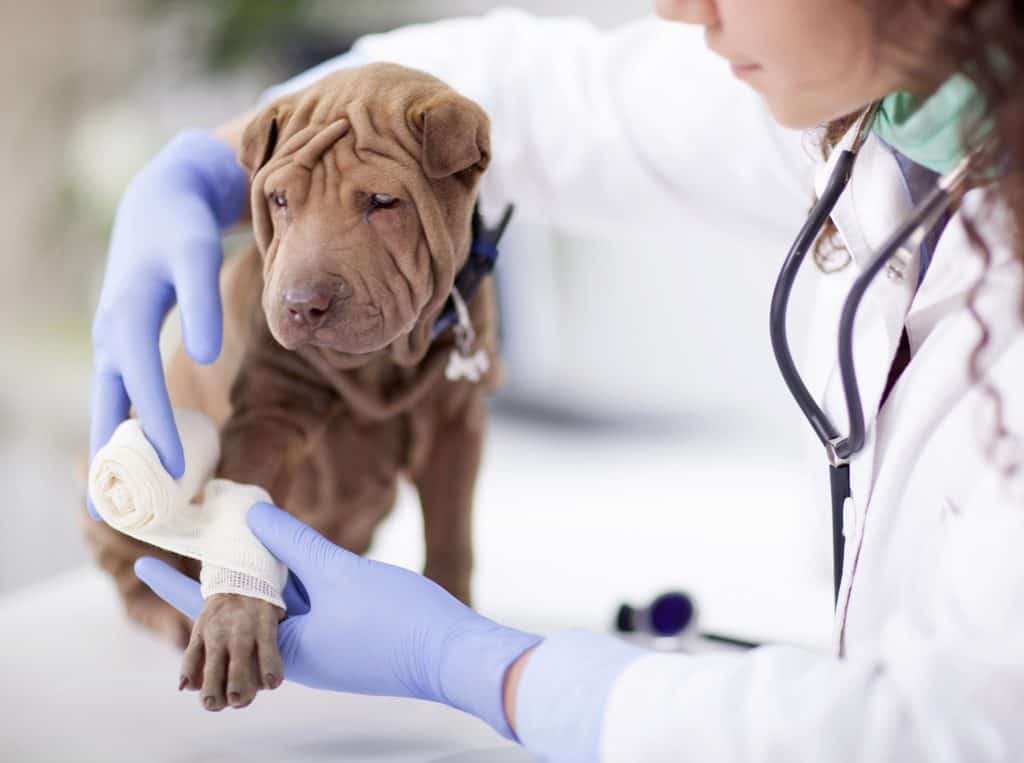
Chinese Shar Peis are prone to the same bacterial and viral infections-the same as other dogs.
- Distemper Vaccine
This severely affects the organs of the Shar Pei such as the spinal cord, respiratory system, brain, and intestines.
The common symptoms of having distemper are high fever, lethargy, loss of appetite, etc.
- Pravo
This disease spreads through the infected dog’s hair or feet. It is fatal.
Usually, if Shar Pei are under a year, they are prone to this virus.
Signs that your dog could have this are bloody diarrhea, depression, vomiting, fever, etc.
- Rabies
This is a very damaging virus; it deteriorates the brains of all mammals.
Suggested: Guide To Dog Vaccination
Dogs secrete large amounts of this virus in their saliva and thus, a dog is infected with rabies when it is bitten by another dog.
Signs that a dog has rabies can be seen in behavioral changes such as restlessness and aggression. They become hypersensitive to touch, light, sound, etc.
Monthly Expense Estimation
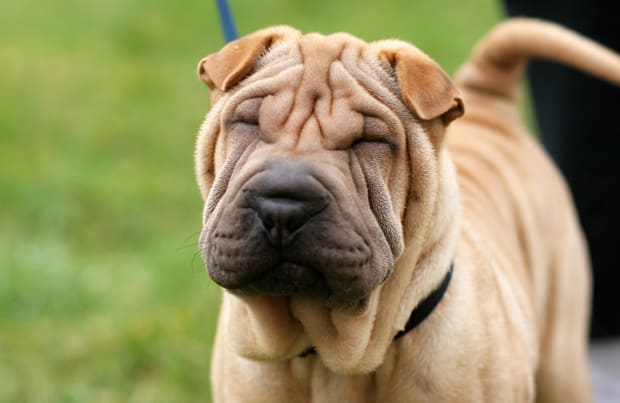
An average Chinese Shar Pei needs $200 per month for maintenance.
Behavior With
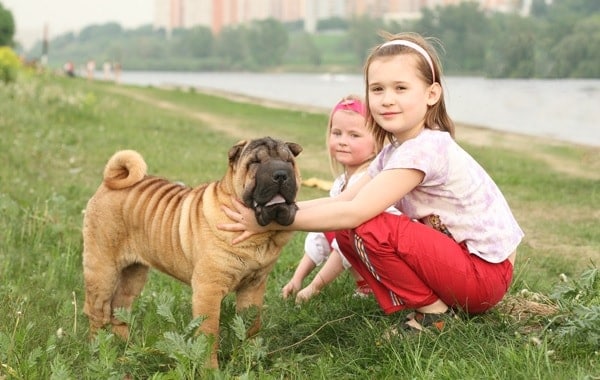
Children:
It is generally said that Chinese Shar Peis are not family pets if you have small children.
They are not the most kid-friendly dogs. Due to their large size, they might physically attack a small child even playfully.
Dogs:
Shar Peis are known to not get along with other dogs too.
They are extremely intolerant of other dogs, they end up getting extremely aggressive in the presence of one.
Cats:
It is not recommended to adopt or purchase a cat if you have a Shar Pei as a pet already.
Shar Peis have a high prey drive and the tendency to chase small furry animals such as cats etc.
Overview
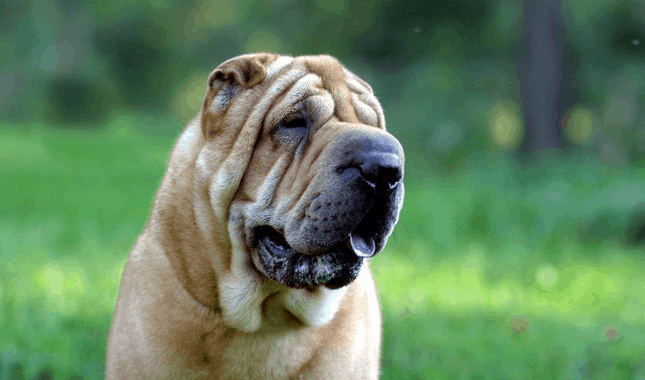
Chinese Shar Pei dogs are ancient dogs from China.
They were initially bred to be fighter dogs but the sport is banned today.
They are an expensive affair but they are very loyal pets.
Their wrinkled skin, blue-black tongues and hippopotamus like muzzle makes them stand out from the crowd.
Something Fun About Chinese Shar Pei!
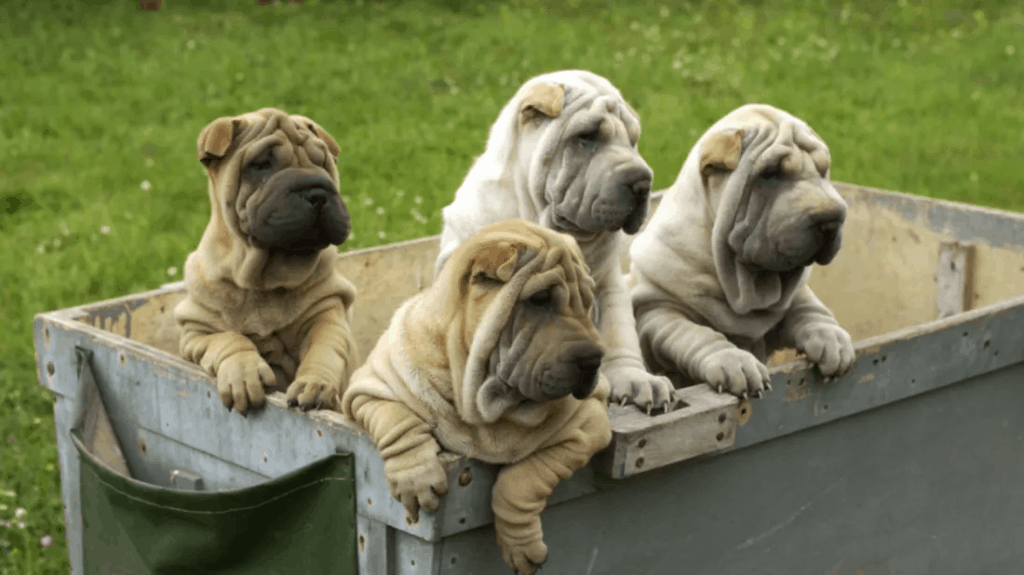
They were bred in China about 2000 years ago.
The communist regime in China nearly ended the breed.
The name Shar Pei literally means “Sand Paper Skin”.
The Chinese Shar Pei lifespan is 9-11 years.
They have unique blue or black, lavender-colored tongues.
They highly resemble the dog breed Chow Chow.
This was all about Chinese Shar Pei.
Let us know about your thoughts in our comment section!
Stay with us to know more about dogs and dog breeds.





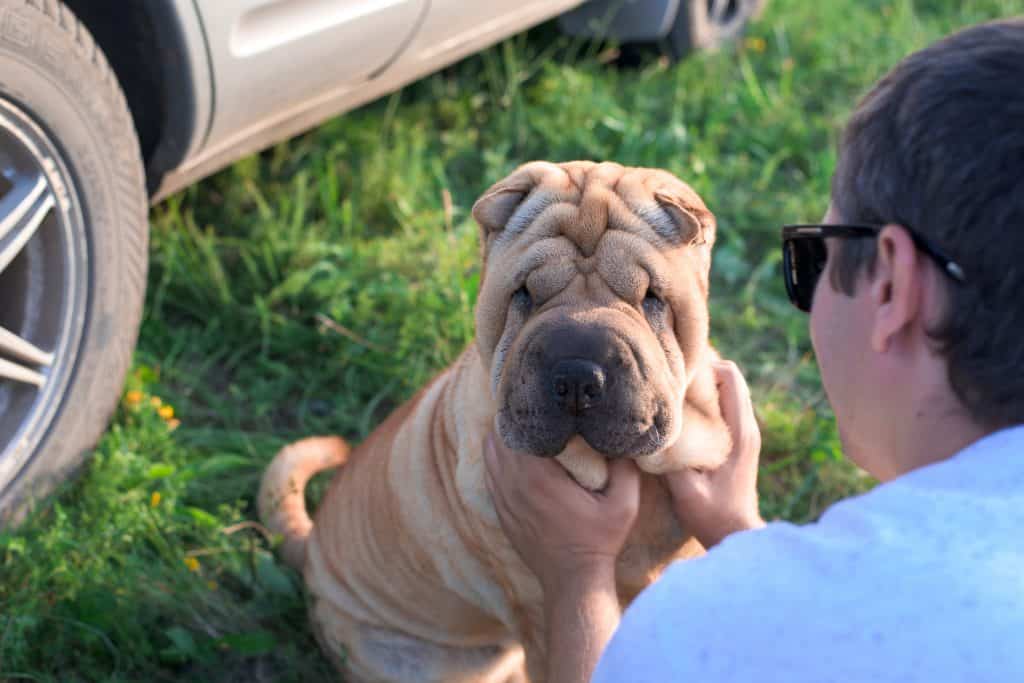

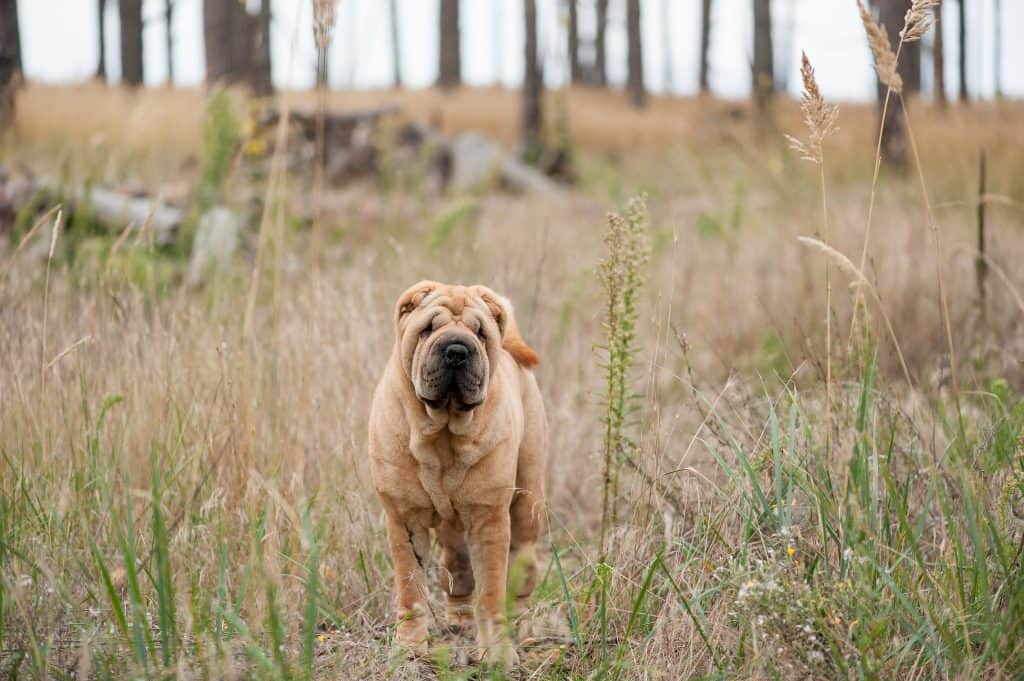
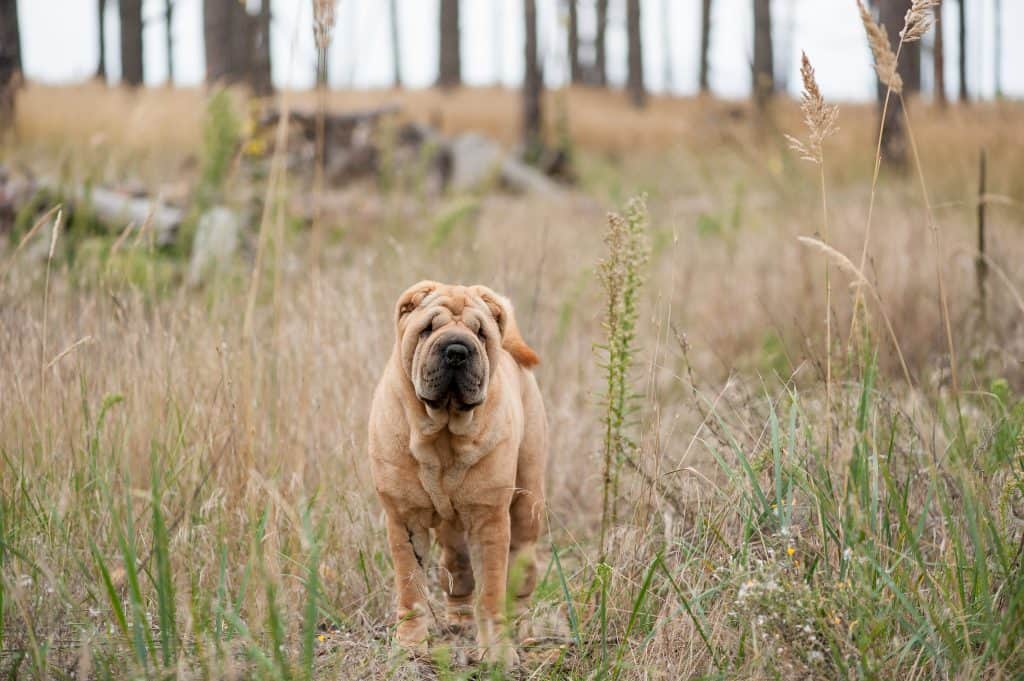








[…] Shar-pei […]